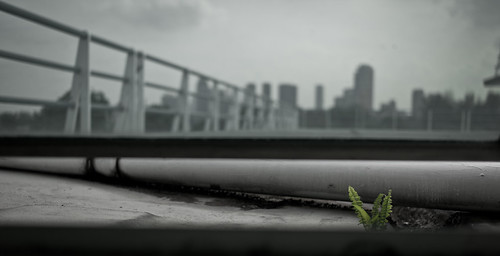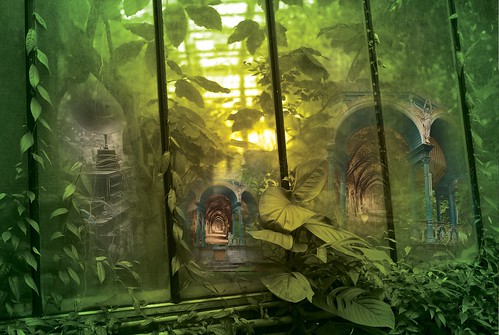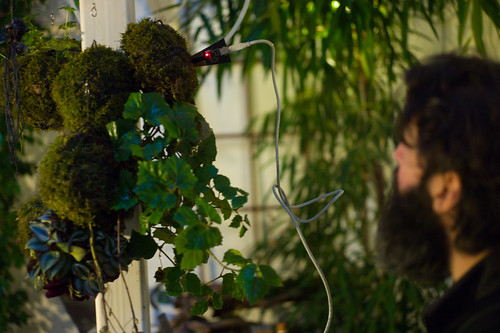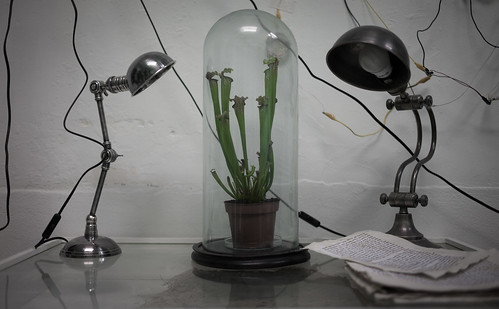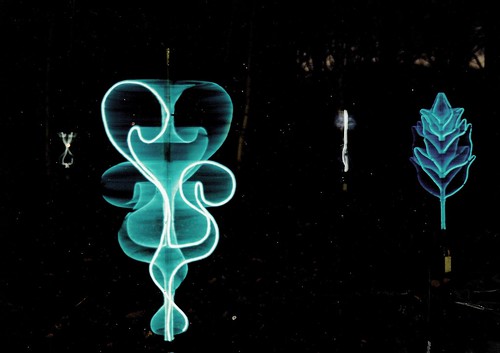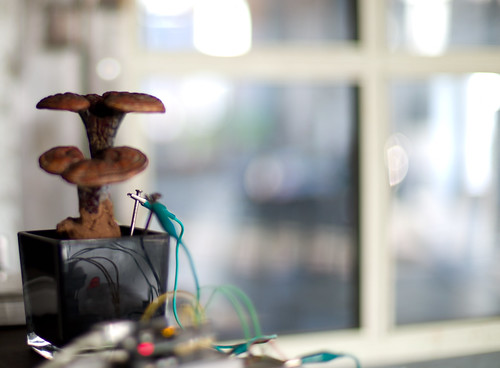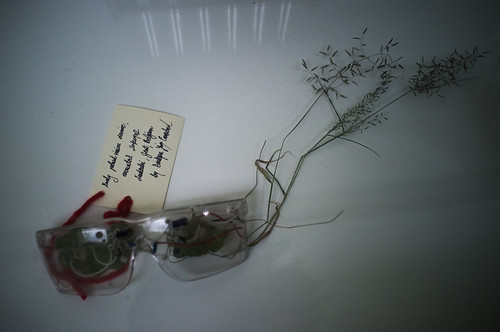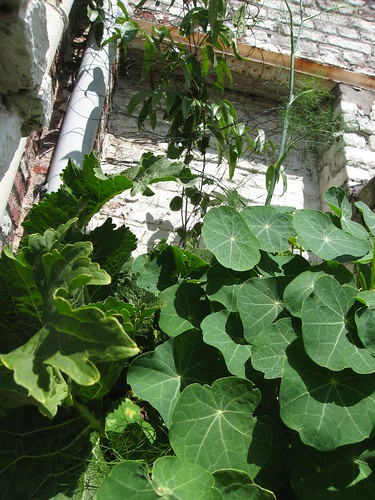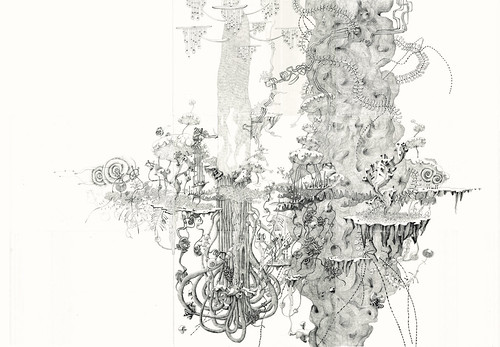Table of Contents
GroWorld: Experiments in vegetal culture
By Maja Kuzmanovic, Nik Gaffney and FoAM
Culture, in the sense of cultivation of minds and behaviours, is one of the most enduring phenomena through which we shape our world (Brand 1999). We leave religious sites, shipwrecks and public art as hand-prints on the environment we share with other species. Enhancing and depleting ecosystems. Some preindustrial societies saw themselves as a part of ever-widening cycles of nature. We can still experience their silent memorials in the form of animist and Buddhist temples in Asian landscapes, or pagan sites scattered throughout Europe. With the advent of the industrial age and modernism, European cultures became increasingly divorced from the non-human “planetary other” (McKenna 1992), so that the two evolved in parallel for a while, only to begin converging again in unlikely places such as sites of failed industrial experiments. The Chernobyl “involuntary park” is a marvel of biodiversity and adaptation to a technological disaster (Sterling, retrieved 2010). Abandoned factories in the German Rühr are now colonised by cultural initiatives, such as the Zollverein. Both cultural and natural changes are slow but tenacious forces often marginalised in a world dominated by economic rationalism. They are messy tangles of emotional, spiritual and physical values, irreducible to simple graphs and statistical analysis, and as such are often ignored.
On the other hand, technology – another human contribution to the planetary ecosystem – is embraced by the same economic and political powers as a panacea to most contemporary challenges, from environmental turbulence to financial crises. From prehistoric seed-collecting and early agricultural ploughs through to nanotech, technology has become a persistent mark of humanity, in the shape of tools and techniques through which we analyse and interact with the world. Although how we use and think about technology has had a substantial influence on cultural changes and the eco-systems we live in (digital technology being the most recent example), it can never fill the cultural void left in the wake of the erosion of the grand narratives of the 20th century. Technology in isolation cannot provide truly encompassing visions of what a society could become, even though we have attempted to understand culture (and the whole universe) in terms of technological models – as clockwork, steam machine, or computer. The limitations of these models have become gradually apparent as science (and common sense) has dug deeper into the fundaments of reality. Now, after ages of superimposing technological worldviews on living systems, perhaps it is time to evolve technology from life.
“The word ‘technology’ derives from technē, a Greek word that originally referred to the labours of the smith and other craftsmen. The analogous Greek word for the labours of the farmer is erga or ‘work’ … For the Greeks, the smith was a solitary figure, whose technē was a jealously guarded secret connecting him to the powers of the underworld through the god Hephaestus. In contrast, the erga, or work, of the farmer was public, involving the whole society and most of the gods. Both activities (smithing and farming) involved ritual, but in the case of technē the rituals were secret and individual, whereas erga are public and collective.”
– J. Stephen Lansing
In his essay “Plan/Plant/Planet,” Terrence McKenna proposed that plants could provide organisational principles for life in the 21st century. McKenna speculates about a society where humanity embraces the slowness and introspection of a vegetal culture, cyclical time, atmosphere-based economy, symbiotic and interdependent collaboration, and other qualities of the “vegetal mind.” Plants are able both to sustain themselves and replenish their surroundings – photosynthesizing, detoxifying their environment and recycling waste. They are resilient and adaptive, without sacrificing the freshness, suppleness and grace that we tend to associate with fragility. Plants can inspire a “new paradigm capable of offering hope of a path out of the cultural quicksand” (McKenna 1992).
Borrowed scenery
Culture needs both human and non-human elements to evolve. As Hakim Bey says: “The elimination of the non-human invokes the elimination of the human: culture can only be defined in relation to what it is not” (Bey 1996). The interplay between cultivated and wild, or man-made and and non-human is beautifully embodied in the concept of “borrowed scenery” in Chinese and Japanese gardening. Jiejing and shakkei gardens borrow their surroundings as elements of their design (Mehta and Tada, 2008). Mountains and rivers, sky and rocks are drawn into the garden and become a part of its narrative. Even though the plants cultivated in the garden and the untamed formations of faraway landscapes are topographically separated entities, they are experienced as part of one whole. The origins of jiejing lie in Buddhist temples, where gardens were designed as meditative spaces, with a hint of geomancy. Early Buddhist temple gardens in Japan used shakkei as a way of teaching humility and the interconnectedness of all beings in a layered reality. Several Buddhist meditation practices (such as mettā or tonglen) start with a focus on oneself which is gradually expanded, layer by layer, to include the Earth, the whole universe, and all sentient beings. Similarly, a shakkei garden includes its human inhabitants and their gaze, drawing them from the cultivated foreground towards the focusing frame of the garden's edge, and finally into the background – the wild, uncontrolled, borrowed scenery. Over the centuries the spiritual connotations faded, and shakkei became a design technique used to give the garden a painterly depth and let its edges humbly diffuse in the surroundings. Borrowed scenery gardens can be seen as miniatures of a botanically-inspired culture, with plants and humans as interconnected layers of a planetary ecology. Rather than seeing them as separate entities, we shift perspective and treat cultures of plants and humans as a part of the same picture, where they complement and enrich each other.
“For planting ground is painting a landscape with living things and I hold that good gardening takes rank with bounds of the fine arts, so I hold that to plant well needs an artist of no mean capacity.”
– Gertrude Jekyll
Viriditas and Thalience
The interconnectedness of the human and the vegetal has been a recurring, age-old theme in art, science and religion. Medieval healer and mystic Hildegard of Bingen wrote about plants radiating a greening life-force (Roth 2000), which she called viriditas. Any translation of viriditas into words and symbols would remain inadequate, but it is a phenomenon that can be viscerally experienced by most humans. Viriditas can be felt while walking through a lush forest, or picking leafy greens from a garden. It is the feeling of freshness and incomprehensible greenness, a quiet, elemental consciousness permeating all life. Sadly, the cultural values of our times seem to have strayed away from viriditas in favour of the active aspects of our animal attributes – speed, expansion, predation and consumption. The balance has tipped toward the bestial side of humanity at the expense of the vegetal. However, we can reacquaint ourselves with viriditas when we slow down, become still but acutely present, like a plant. We can witness viriditas in our own resilience, awareness, compassion and contemplation.
“Most noble
evergreen with your roots
in the sun:
you shine in the cloudless
sky of a sphere no earthly
eminence can grasp,
enfolded in the clasp
of ministries divine.”
– Hildegard Von Bingen
While viriditas can be an experiential and spiritual muse of a vegetal human culture, for the analytically inclined a more empirical approach to the idea of vegetal sentience is needed (aside from the well-known psychedelic and shamanistic perspectives). Justifiably, before encouraging development of a vegetal mind in humans, we’d like to understand the plant’s point of view first, rather than modelling our human existence on an incomplete interpretation. We might want to engage with the botanical kingdom directly, and grasp how plants perceive and communicate. There are several examples from both mainstream and fringe science looking at plant perception, signalling and sentience. Daniel Chamovitz recently wrote about how plants experience and respond to the world (Chamovitz 2012). Plant neurobiology developed in the last decade as a scientific discipline researching plants' signalling and adaptive behaviour (Barlow 2008). On the edges of scientific replicability, we find Clive Backster's biocommunication experiments with a specimen of Dracena Massengeana connected to a polygraph (Backster 2003), or the imaginative crescographs by Jagdish Chandra Bose and Randall Fontes (Theroux 1997). These experiments look at plant growth and movement in response to external stimuli, and attempt to understand plant perception and communication.
Venturing to communicate with plants would require humans to grasp the logic of the “vegetal mind.” Plant consciousness would no doubt be considered alien and impossible to perceive without assistance. This is where knowledge of human-computer interaction might be informative. The field of computer science has developed a variety of methods to determine the nature of machine mind by comparing it to the human mind (the Turing test being the best known example). However, it is quite anthropocentrically arrogant to think that human sentience, perception and behaviour is the only possible expression of consciousness. Why measure sentience by how well it mirrors that of humans? Nature may contain a myriad of disparate sentiences, operating according to their own internally consistent, externally incomprehensible logic. We might be “hearing their voices” daily, but having no sensory and mental capacity to translate and interpret their meaning. Perhaps we should focus our energies on “an attempt to give the physical world itself a voice so that rather than us asking what reality is, reality itself can tell you” (Schroeder, retrieved 2008). Writer Karl Schroeder called this “post-scientific” communication with non-human sentient beings “thalience.” A plant-inspired culture could benefit from getting to know its verdant neighbours from a range of perspectives, including direct and unmediated experience, moving away from teleological, utilitarian and reductionist analyses of human relationships with plants. Schroeder talks about “non-human intelligences who come to different conclusions about what the universe [is] like” (Schroeder, retrieved 2008). Plants are such “non-human intelligences” with whom we share the same universe, yet the way in which they experience the world remains beyond our grasp.
“We have nothing in common with the Geometers. No shared experiences, no common culture. Until that changes, we can't communicate with them. Why not? Because language is nothing more than a stream of symbols that are perfectly meaningless until we associate them, in our minds, with meaning; a process of acculturation. Until we share experiences with the Geometers, and thereby begin to develop a shared culture – in effect, to merge our culture with theirs – we cannot communicate with them, and their efforts to communicate with us will continue to be just as incomprehensible as the gestures they've made so far.” – Neal Stephenson
groWorld sym-bio-sys
At the intersections of culture, gardening and technology we can start to see how plants can become organisational principles for human society in the turbulent times of the 21st century. Although we may need to scavenge at the fringes of contemporary society, we can observe many healing effects that humans can have on their surroundings through a symbiotic collaboration with plants. Some fight desertification and remediate industrial wastelands through natural farming and permaculture. Others design whole lifecycle, closed-loop technological and architectural systems inspired by natural processes, based on the art and science of biomimicry. Yet, these are scattered examples. We still don’t have widespread methods to improve wasteful, often counter-productive human behaviours. How do we encourage broader, longer-term cultural changes? What varieties of culture would be capable of forging symbiotic relationships between postindustrial human societies and the rest of the earth? How do we compost bitterness to grow beauty?
From these questions and assertions sprouted the groWorld initiative, a long-term inquiry into human-plant interactions and their effect on the longevity of human culture. The people of FoAM – a distributed laboratory for speculative culture – initiated groWorld to “minimise borders and maximise edges” between the man-made and the vegetal. In these zones of liminality and ambiguity, groWorld abets “unholy alliances” between contemporary culture and cultivation, building and growing, botany and technology. Inspired by the way in which plant species propagate – spanning multiple temporal layers – the initiative encompasses both long- and short-term explorations. The slow processes of cultural adaptation and plant cultivation are researched across several decades, through observation and interaction. At the same time, quick technological and social changes are incorporated through techno-artistic experiments in three interconnected branches: {sym}, {bio} and {sys}. The {sym} branch looks at how human culture can be infused with vegetal characteristics: in botanical fiction, plant games, active materials, and responsive environments. The {bio} branch is about a direct collaboration with plants, using age-old techniques of foraging and gardening and seeing cities as edible landscapes for humans and non-humans. Finally, {sys} deals with botanically-inspired technologies that can help humans engage with plants beyond the physical level, through sensing, perception and perhaps even communication.
Through a cross-fertilisation of {sym}{bio}{sys}, groWorld merges digital culture with environmentalism. Both approaches promote empowerment of trans-local communities and are rooted in self-reliant maker-cultures, yet they don’t often mingle. groWorld encourages their interaction by bringing programmers and gardeners, gamers and botanists together on the common ground of the arts. Together, they create hybrids of gardening and technology, or narrative realities where human and vegetal can merge into a unified, hybrid culture.
From planetary to human scale: responsive environments
groWorld sprouted from conversations between artists, engineers and activists at the Burning Man Festival in Nevada in 1999. In the heat of the scorched desert, under the shade of the looming millennium, our futures seemed riddled with insurmountable dilemmas. What should we carry over into the next century? Would we still be the guardians of our own skin, or would we fall under a portfolio of patents, together with rice and ancient medicinal plants? Will humans still be around in next ten thousand years? Will we walk through fertile jungles, majestic forests and buzzing meadows, or will we live underground - below sterile deserts and toxic swamps? Could we escape to outer space? Will we reach the stars? All of these questions were about events on a planetary scale that spanned glacial time, that made us wonder how could any of our individual contributions make a difference? Who isn’t tired of being chastised for not doing enough for the environment, or apathetic when one doesn’t perceive any desired effects in one’s own lifetime? We were thirsty for a sense that our presence in the world matters and that the effects of our actions could be shared with others, as proposed in the theory of consilience (Wilson 1998) and the practice of urban gardening (Wilson 1999).
It was time for us to bring conversations down to the human scale and offer participants a direct experience of the effects we can have on our immediate surroundings (in real time and in a circumscribed space). FoAM designed a forest of phantasmagoric robo-botanical trees that surrounded a responsive domed shelter – the “growth bunker.” In the warmth of the bunker, visitors were immersed in electro-luminescent light and generative sound – an environment designed to respond to people’s voices and movement. Within this space, the environmental effects of their conscious and unconscious actions became instantly apparent. As in Wim Wenders’ movie Until the End of the World, people became intoxicated by the experience of their actions rippling through the growth and decay of biomorphic light and soundscapes. The interplay between people’s actions and environmental responses encouraged deceleration and engagement. The expected instant gratification of digital entertainment was substituted with meditative explorations of ambient changes.
From human to vegetal scale: plant games
After seeing the effects of human-scale interaction in responsive environments, groWorld collaborators broadened their investigations into human-computer-plant interactions (HCPI). HCPI allows people to perceive the environmental effects of their actions on a human time scale, using their naked senses rather than having to wait years or decades when it may be too late to respond. After a winding path through gardens and forests, the investigation led to experiments with computer games. Games in which humans could play a plant. The challenge here was to move away from instrumentalising plants to empathising with them – experiencing the sensations of “being” a plant, rather than “doing” things to plants, as gardeners or designers. As there are no definitive translation mechanisms (yet) to ask a tree or a herb what being a plant really means, the game designers relied on their own observations and imagination. Being a plant meant reaching a state of mind where stillness, slowness and beauty provided energy and incentive to playfully explore, give up control, grow and decay, create and destroy, perhaps even experience viriditas through human fingertips. Games could become a way for humans to exercise their forgotten vegetal reflexes and experience the delight of patience, growth, diffusion, ambient perception, chemical communication, and a continuous quest for light and moisture.
Making the inward-oriented beauty of plant life compelling in the context of computer games is challenging. FoAM collaborated with game designers Tale of Tales to explore what it means to play a plant on a computer screen. To investigate whether there could be consilience between game design, botany and permaculture, the team prototyped a series of mini-games. One approach involved connecting physical plants to sensors so that information about their physical environment would influence the “weather” in a digital garden. In another prototype, plant collaboration (as understood in permaculture) was used as a starting point for developing game mechanics.
Having experimented with the “first-plant perspective” in a collection of prototypes, attention shifted back to “playing with plants,” this time in the collaborative spaces of online social networks. Germination X is an attempt to introduce plants as guides in creating self-sustaining digital gardens, as a response to the industrial farming game Farmville. FoAM designed a prototype in which players are guided by autonomous “plant spirits” to grow virtual permaculture guilds, where diverse plants work together to grow and propagate. Zizim was one outgrowth of Germination X that focused on reconnecting the game world to physical locales. Zizim (“compass” in Hildegard's Lingua Ignota) emerged as a hybrid between a mobile app and an online game, exploring the interaction between urban foraging and the symbiotic relationships between plants and fungi.
All of the groWorld prototype games play with human interpretations of plant sentience. Until we are able to convince a plant to help design a game about its own life, the number of possible viewpoints, backstories and gameplays are limited only by the imagination.
“I effuse my flesh in eddies
and drift in lacy jags
I bequeath myself in the dirt
to grow from the grass I love
If you want me again, look for me
under your boot-soles”
– Walt Whitman
From plants to stories: patabotany
Designing games where humans play a plant based on a human understanding of plants may sound rather paradoxical. To take this incongruity further, groWorld devised a creative experiment which folds human interpretation of plants back on itself. Patabotany is a hybrid between ethnobotany (the study of cultural, spiritual and medical uses of plants) and pataphysics, the science of imaginary solutions (Jarry, 2001). Patabotany poses the question: what if the metaphors, cultural rituals and myths associated with plants could be discovered in their physical properties – in their shapes, colours and functions? If mushrooms were in fact aliens attempting to communicate with us, what organs could mushrooms and humans grow to improve reciprocal communication? If red roses were able not just to symbolise love, but write love letters through chemotropism, guided by lovers’ pheromones? If the soil purifying plant could in fact turn heavy metals into precious rings? Patabotany is a cross-pollination between myth and reality: it is an interpretation of interpretation, an abstraction of abstraction, emerging at the edges of poetry, magic and biology. Patabotany subverts the contemporary drive to instrumentalise culture and nature in economic or utilitarian constructs. It describes a world where the believable is grafted onto the improbable, where logic is pollinated with a hybrid of sensuality and paradox, where botany and permaculture mutate into an epic of nurturing and seduction in relentless cycles of living and dying.
In groWorld patabotany was grafted onto Tarot, a known storytelling and divination platform with its roots in card games and magic of the Italian Rennaissance. FoAM cross-bred tarot archetypes and ethnobotanical properties of plants – as the adventurous Fool or the mysterious High Priestess – with patabotanically-evolved morning glory and lady's mantle. Some of the chosen plants share history, morphology or geography with the human archetypes, others are able to induce archetypal body and mind states or inhabit the same pataecology. Patabotanical Tarot builds on a peculiar and mysterious history of plant books, which includes such curiosities as The Voynich Manuscript (Kennedy 2005, Voynich, retrieved 2011), Parallel Botany (Lionni 1978), Codex Seraphinianus (Serafini 1981) and Tolkien’s Plants of Middle Earth (Hazell 2007). The Voynich Manuscript, for example, allegedly written in the 15th or 16th century, contains hundreds of herbal, astronomical, biological, cosmological and pharmaceutical drawings and recipes. The manuscript is not written in any known language, and has resisted all attempts at translation; many believe it is a hoax. The plants detailed in this strange manuscript do not match any known species. In a way, the Voynich Manuscript represents a “secret knowledge” of a possibly fictional, possibly alchemical universe, and as such it has engaged and fascinated scholars for hundreds of years. Parallel Botany, a more recent example by a known author, is a collection of faux scientific descriptions of plants, backed by invented mythologies and folktales from around the globe. Parallel plants have the ability to defy perspective, exist as music, or evaporate when touched. There is so much that we don’t know about our vegetal neighbours that even the most scientifically-minded among us have been unsure how much of this work is fact and how much fiction. Patabotany is a similarly entangled milieu, where botanical truths are questioned through juxtapositions with traditional myths and popular beliefs, interspersed with personal dreams and collective speculations.
If patabotany can inject stories and other products of human imagination into botany, could it not also inspire the development of a “vegetal mind” in humans? What would happen were patabotany to seep back into the reality of everyday life? What if patabotany could sprout through email clients and cracks in pavements? People would encounter it online, through games and apps, and in the real world – in gardens, parks and green patches by the side of the road. By straddling the online and offline world, the realms of gamers and of gardeners, patabotany could engage people in an immersive story and reinvigorate the relationship between people and plants.
In an attempt to infuse physical spaces with patabotanal essences, FoAM created Borrowed Scenery, a story about an alternate reality (past, future or parallel) where plants are a central aspect of human society. Borrowed Scenery encourages us to re-imagine our cities as places of sinuous interaction between humans and plants: where plants don’t just provide us with food and materials but become neighbours, teachers, and gateways to the “Planetary Other”. Borrowed Scenery is an alternate reality narrative about the dissolution of borders between reality and fiction, mysticism and technology, nature and culture. It is a story that wants to become a reality. Its characters - a group of patabotanists attempting to re-establish human-plant communication - include evolved tarot-plant hybrids, as well as living humans. They leave physical traces, such as notebooks, used teacups and experiments-in-progress. Their words appear in online forums, on Open Street Maps, in games and wikis. They speak various plant languages and sometimes communicate in Hildegard von Bingen's Lingua Ignota. The patabotanists remain elusive and always just out of reach, yet their lab and their arcane equipment, collected specimens and peculiar library is open to curious passers by. In a hidden indoor jungle, the patabotanists' world can be found, with their research assistants, ongoing experiments, or a cup of herbal tea providing an entrance. From this makeshift lab their work spills out onto the streets, to map remarkable plants and gardens, seeking out plants, people and places with porous edges between the human and the vegetal. By 'borrowing' the setting of everyday life in the city, it attempts to infuse our habitual activities, such as walking or eating, with a vision of a possible future where insatiable economic growth is superseded by an atmosphere-based economy, where nature has a voice. A voice that we can hear in the weather, in communication protocols and in our own thoughts. In Borrowed Scenery we can viscerally experience ourselves as inseparable from the world, with our feet connected to tangles of mycelium, roots and soil, while our awareness mingles with the vegetal, animal and elemental.
“If the light is sufficient to disclose to us the way of contemplation that lies within ourselves, we may by pursuing it to the end. We may know – not as a mere static dictum but as a winged intuition, carrying an infinitude of significance both for mind and heart – that the One IS the Manifold, and the Manifold IS the One.”
– Agnes Arber
From stories to reality: gardening a vegetal culture
Speculations on human-plant interaction cannot but begin and end in gardens. Gardening can be seen as one of the earliest collaborative efforts between humans and plants, and has been commonly regarded as the cornerstone of early human civilisations. Michael Pollan even considers farming to be a human service to plants, assisting a few species (such as corn or orchids) to dominate over others (Pollan 2002, 2007). Regardless of who is serving whom, gardening can be seen as a mutually beneficial interaction between plants and humans. Natural farming (Fukuoka, 1990) provides valuable exercises in human-plant interdependence: living proof that it is possible to feed humans by feeding the environment. Permaculture principles (Holmgren 2002) including “observe than interact” or “use edges and value the marginal” can be applicable in urban regeneration, economic development and creative endeavours in art, design and technology. To cultivate a vegetal human culture, gardening should be seen as a cultural phenomenon.
“Horticulture is next to music the most sensitive of fine arts. Properly allied to Architecture, garden making is as near as a man may get to the Divine function…”
– Maurice Hewlet
Gardening can be a purposeful cultivation of plants as food and medicine. It can also be a meditative activity that allows us to contemplate the effects of our actions on our immediate surroundings. Alternatively, gardening can become a collective endeavour that brings communities together to resist monocultural hegemony. Gardening is humanity’s most direct hand-to-leaf interaction with living plants. In groWorld, gardening has taken on all of these dimensions – growing food, meditating, and building a community; whether through growing plants on windowsills, rooftops, back-yards, church yards, unused lots or public parks. To create urban gardens groWorld follows permaculture principles, specifically focusing on the techniques of permaculture guilds and companion planting (Holmgren, 2002). These techniques are based on creating permanent, self-sustaining gardens through “collaborations” between individual plants. Guild gardening is advantageous in urban settings, where it is used to grow a variety of species in small spaces and keep scarce soil fertile for as long as possible. In Brussels, FoAM's experiments focused on medicinal plant guilds that can thrive on roofs and balconies, including native fennel, wormwood and nasturtium. In Amsterdam, FoAM engages local communities in redesigning church gardens to form edible parks, centred around hardy native plants – the guilds of raspberries, marigolds, garlic and many other common edibles.
groWorld’s vision of urban gardening doesn’t stop at fenced-off back-yards and allotments, it sees cities as continuous green passages from industrial to vegetal culture. Since the begining of the millenium, groWorld’s gardeners have been spreading and harvesting native flora in industrial zones, city centres and abandoned lots – in Belgium, the Netherlands, UK and Australia. We share the views of Urbanibalism that “the city should become a natural source of food and a place for diverse forms of life that grow autonomously from any planned city ecology. The city becomes a spontaneous convivium” (Maas and Pasquinelli, Retrieved 2010).
Even though postindustrial cities have the potential to become spontaneous conviviums, consumer culture, privatisation of public spaces and propagation of indoor entertainment have taken many a citizen away from the vibrant freshness and wind-blown vigour of urban gardens and parks. Some city-grown children don’t realise that meat was once the living flesh of animals; many urbanite adults don’t recognise edible plants growing under their feet. To assist with spotting and sharing information about food sources that surround them, FoAM in Amsterdam developed Boskoi, an interactive survival guide for urban foragers equipped with mobile phones. The Boskoi app displays edible species in an area, accompanied by expert advice from seasoned gardeners and botanists. With the assistance of Boskoi, even a novice forager can stroll through the city after work and casually collect herbs, fruits or vegetables to add to their dinner.
For more dedicated plant enthusiasts, interested not just in foraging but also seeding edible urban landscapes, groWorld’s collaborators organise workshops in seed-balling (or seed bombing), urban gardening and guerrilla grafting. Seed-balls, so named by Masanobu Fukuoka (Fukuoka 1990), are small balls made of red or brown clay, vegetal compost, and a carefully picked mixture of seeds. Planting the balls does not require digging, which makes them perfect vehicles for spreading in the city. groWorld’s seedballs contain seeds that can become “weedscapes” of native plants: able to replenish and purify the soil in urban and industrial zones, and edible for urban dwellers – human and animal. A step further in plant propagation is the ancient skill of grafting, which involves interchanging parts of related or similar plant species. In orchards, grafting is nowadays rarely applied on adult plants, but all young fruit trees are grafts of a good fruit-bearing type onto a plant selected for its roots, which results in a hybrid combining the best of both. FoAM in Amsterdam began experiments with grafting wild and domesticated apples in the city, aiming to increase urban biodiversity and opportunities for pollination. One of their first grafts was a wild apple found near the Sloterdijk train station bound to a domesticated Golden Delicious in FoAM's garden. In autumn of 2012 this hybrid produced the first Rough (Golden) Sloterdijk apples, whose rough exterior covers an juicy flesh rich in taste, with hints of cinnamon and juniper.
Not so long ago urban gardening was an activity relegated to marginalised subcultures and immigrant communities. Nowadays, large numbers of the urban population grow at least some herbs in their kitchens once again. Since the financial crisis of 2008 and increasingly unpredictable environmental upheavals, there is much demand for and attention to growing food in cities. Some of groWorld's gardening activities that were ignored by cultural institutions in the early 2000s have recently begun to become part of mainstream culture. Avant Gardening prophesied that “gardening will emerge as one of the major economic forces of resistance” (Wilson 1999). A little over a decade later, urban gardening is practiced not just by the members of the “cultural resistance” but by people from all walks of life – ranging from the American first lady, uprooted people in European refugee centres, to school children in Australia and overpopulated favelas in Brazil.
“Arranging flowers is arranging ourselves. We're all flowers.”
– Thich Nhat Hanh
Plants are entangling urban culture, entwining art and science, emerging through cracks in pavements and doors blown open by turbulent weather. Humans have curious relationships with plants - from digging for gnarly sprouts in parched deserts to battling vigorous tangles in dense forests, from building tree-houses on mountain peaks to hoisting vertical gardens in sprawling urban jungles. We cultivate plants to cultivate humans. To cultivate the garden within.
“Suddenly I realise
That if I stepped out of my body I would break
Into blossom”
– James Wright
Acknowledgements
With thanks for the contributions from Alkan Chipperfield, Dave Griffiths, Adrian Hon, Martin Howse, Theun Karelse, Lina Kusaite and Lionel Billiet.
groWorld is an initiative of FoAM: http://fo.am/groworld
groWorld collaborators include: Maja Kuzmanovic, Nik Gaffney, Dave Griffiths, Martin Howse, Theun Karelse, Cocky Eek, Alkan Chipperfield, Lina Kusaite, Rasa Alksnyte, Shelbatra Jashari, Paola Orlic, Claud Biemans, Tale of Tales, Six to Start, Bartaku, Christina Stadlbauer, Steven Pickles, Wietske Maas, Angelo Vermeulen, David Tonnessen, Chris Salter and Anke Burger. more details can be found at http://fo.am/groworld/
References
- Arber, A. (1957). The Manifold and the One. John Murray Publishers.
- Backster, C. (2003). Biocommunication with Plants, Living Foods, and Human Cells. White Rose Millennium Press.
- Peter W. Barlow (2008). “Reflections on ‘plant neurobiology.’” BioSystems 92, pp. 132–147.
- Bey, H. (1996). Millennium. Autonomedia & Garden of Delight.
- Beyst, S. (2002). “Andy Goldsworthy: The Beauty of Creation.” Retrieved 01 February 2010 from http://d-sites.net/english/goldsworthy.htm
- Brand, S (1999). The Clock of the Long Now: Time and Responsibility. Basic Books.
- Brand, S. (2009). Whole Earth Discipline: An Ecopragmatist Manifesto. Viking Penguin.
- Chamovitz, D. (2012). What a plant knows. Scientific American / Farrar, Straus and Giroux
- Fukuoka, M. and Metreaud, F. P. (1990). The Natural Way of Farming: The Theory and Practice of Green Philosophy. Japan Publications.
- Hazell, D. (2007). The Plants of Middle-Earth: Botany and Sub-creation. Kent State University Press.
- Highley, S. L. (2007). Hildegard of Bingen's Unknown Language: An Edition, Translation, and Discussion. Palgrave Macmillan.
- Holmgren, D. (2002). Permaculture: Principles and Pathways Beyond Sustainability. Holmgren Design Services.
- Hort, A. (1938). The Critica Botanica of Linnaeus. Ray Society.
- Kennedy, G. (2005). The Voynich Manuscript: The Unsolved Riddle of an Extraordinary Book which has Defied Interpretation for Centuries. Orion Publishing.
- Lansing, J. S. (1991). Priests and Programmers: Technologies of Power in the Engineered Landscape of Bali. Princeton University Press.
- Linnean Herbarium: http://linnaeus.nrm.se/botany/fbo/welcome.html.en
- Lionni, L. (1978). Parallel Botany. Alfred A. Knopf.
- Lowenstein, O. (2004). “Beauty in the Brand: The work of Andy Goldsworthy as challenge to radical relativism.” Retrieved 05 May 2006 from http://www.fourthdoor.co.uk/unstructured/unstructured_03/05.html
- Jarry, A. (2001). Adventures in Pataphysics: Collected Works I. Atlas Press.
- Kellaway, D. (1996). Women Gardeners. Virago Press.
- Kuzmanovic, M. and Gaffney, N. (2007). “groWorld HPI: Speculation on the evolution of human-plant interactions.” Retrieved on 01 February 2010 from Mutamorphosis: Challenging Arts and Sciences website: http://mutamorphosis.wordpress.com/2009/02/28/groworld-hpi-speculations-on-the-evolution-of-human-plant-interactions-2/
- Maas, W. and Pasquinelli, M. “Urbanibalism.” Retrieved on May 2010 from http://www.urbanibalism.org/about
- Mahanti, S. Acharya. Jagadis Chandra Bose. Retrieved 01 February 2010 from Vigyan Prasar Science Portal website: http://www.vigyanprasar.gov.in/scientists/JCBOSE.htm
- McKenna, T. (1992). “Plan/Plant/Planet.” In McKenna, T. (ed.). The Archaic Revival. HarperCollins.
- Mehta, G.K. and Tada, K. (2008). Japanese Gardens: Tranquility, Simplicity, Harmony. Tuttle Publishing.
- Pollan, M. (2002). The Botany of Desire: A Plant’s-Eye View of the World. Random House.
- Pollan, M (2007). The Omnivore's Dilemma: A Natural History of Four Meals. Penguin.
- Roth, S. (2000). “The Cosmic Vision of Hildegard of Bingen in The Ecologist.” Retrieved on 01 May 2008 from http://findarticles.com/p/articles/mi_m2465/is_1_30/ai_59520592/
- Schroeder, K. (2001). Ventus. Tor Science Fiction.
- Schroeder, K. “Thalience.” Retrieved on 22 July 2008 from http://www.kschroeder.com/my-books/ventus/thalience
- Serafini, L (1981). Codex Seraphinianus. Franco Maria Ricci.
- Stephenson, N. (2008). Anathem. William Morrow.
- Sterling, B. Retrieved on 10 October 2010 from http://www.viridiandesign.org/notes/1-25/Note%2000023.txt
- Theroux, M. (1997). “Detecting Biodynamic Signals.” Retrieved 22 June 2022 from Journal of Borderland Research website: https://borderlandsciences.org/journal/vol/52/n03/Theroux_Detecting_Biodynamic_Signals_I.html
- Von Bingen, H. trans. Newman, B. (1998) Symphonia: A Critical Edition of the Symphonia Armonie Celestium Revelationum. Cornell University Press.
- “Voynich Manuscript.” Retreived on 10 August 2011 from http://beinecke.library.yale.edu/digitallibrary/voynich.html
- Whitman, W. “Song of Myself.” Retrieved on 05 May 2009 from http://www.daypoems.net/plainpoems/1900.html
- Wilson, E. O. (1998). Consilience: The Unity of Knowledge. Knopf.
- Wilson, P.L. and Weinberg, B. Eds. (1999). Avant Gardening: Ecological Struggles in the City and the World. Autonomedia
- Wright, J. A “Blessing.” Retrieved on 10 November 2007 from http://www.poemhunter.com/poem/a-blessing/
groWorld's kindred people and places
- Borrowed Scenery: http://borrowed-scenery.net
- Boskoi: http://boskoi.org
- Germination X: http://germinationx.com
- PARN. http://fo.am/parn
- Martin Howse: http://www.1010.co.uk/org/
- Stevie Wishart. http://www.steviewishart.com
- Urbanibalism. http://www.urbanibalism.org
- Loop.ph. http://loop.ph
- Biomodd. http://www.biomodd.net
- Phoef. http://fo.am/phoef
- Maki Ueda. http://ueda.nl
- Six to Start. http://www.sixtostart.com
- Tale of Tales. http://www.taleoftales.com
see also: project groworld

